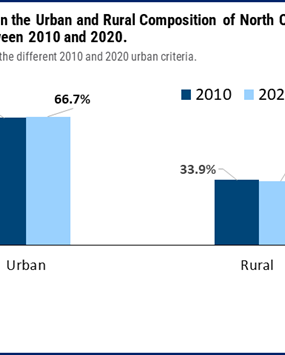Uncategorized
Keep up with our latest demographic insights

In recognition of Veterans Day, Tuesday, November 11th, we are providing some statistics about North Carolina’s veteran population. The most current version was published on November 12th, 2025, with information from 2023 and 2024. Please note that the county veterans data from the Department of Veterans Affairs as of 2023 has been revised since the publication of our last blog post on veterans in North Carolina. This updated profile provides the following key information on…

Breast cancer is the most diagnosed cancer in women and second leading cause of cancer-related death after lung cancer. One in eight women will be diagnosed with breast cancer within their lifetime, and one in 43 will die from breast cancer, according to analyzes by the American Cancer Society. The North Carolina Department of Health and Human Services (NCDHHS) reports that in North Carolina each year more than 8,000 women are diagnosed with cancer and…

Gigi Taylor, a professor in the English department at UNC Chapel Hill, remembers Bhairavi Jayaraman walking up to her after class, nervous about applying to a fellowship opportunity. “Well come on upstairs, I want to introduce you to the dean who shared this opportunity,” Taylor told Jayaraman, then an undergraduate at UNC studying Economics and Public Policy. By the time Jayaraman left the dean’s office, Taylor said, “he was so impressed with her…

In 1993, Amy Pulliam began her journey at Carolina as an undergraduate public policy student interested in health equity and inclusion. Three decades later, she’s coming full circle in Chapel Hill after stints with the North Carolina Department of Health and Human Services (NCDHHS) and multiple North Carolina-based state health partnerships, including Wake Forest Baptist Health and Hospice and Palliative Care of Greensboro, among others. Pulliam will serve as Carolina Demography’s Programs Manager, a role…

The US Census Bureau released the 2020 Census Detailed Demographic and Housing Characteristics File A (DDHC-A) on September 21, 2023. This release provides population and sex by age information for detailed race and ethnicity groups and American Indian or Alaska Native tribes. As an example - while previous releases from the 2020 Census reported White, Asian, American Indian and Alaska Native populations; the DDHC-A release reports data for the Irish, Korean, or Lumbee Tribe populations. …

Many couples today choose to live together prior to getting married, after which the majority of people do get married. In 2021, almost half of all North Carolinians ages 16 or older were currently married, on par with the nation. (This percentage has been steadily decreasing. North Carolina’s currently married population peaked in 1960 – when almost 70% of adults 16 and older in North Carolina were married. That’s the highest percentage since (the Decennial…

In January, we posted a blog by Dr. Mike Cline, the NC State Demographer, “Making Sense of the New ‘Urban Area’ Definitions” in which he addressed the changes to how the Census Bureau defines urban areas. This post details the implications of the definition changes and the changing urban-rural composition of North Carolina’s population in general. First, what do urban and rural mean? To recap, before 2020, the Census Bureau’s definition of urban was based…

We're looking for a new director to lead Carolina Demography! (Job posting here.) Carolina Demography is a demographic research unit sitting within the Carolina Population Center at UNC-Chapel Hill. We translate demographic knowledge into specific usable information to help people throughout North Carolina understand the implications of demographic change. What you'll do You will: Provide direction and oversight to the Carolina Demography unit at the Carolina Population Center. Solicit, manage, and oversee the performance of…

Last week, the Census Bureau released the 2016-2020 5-Year American Community Survey data. Here’s what you need to know. What is the American Community Survey? The American Community Survey (ACS) is an ongoing survey that covers detailed social and economic topics, such as education, employment, internet access, and transportation. Each year*, the Census Bureau releases single-year estimates for places with populations of 65,000 or over and 5-year estimates for places with populations less than 65,000.…
Your support is critical to our mission of measuring, understanding, and predicting population change and its impact. Donate to Carolina Demography today.